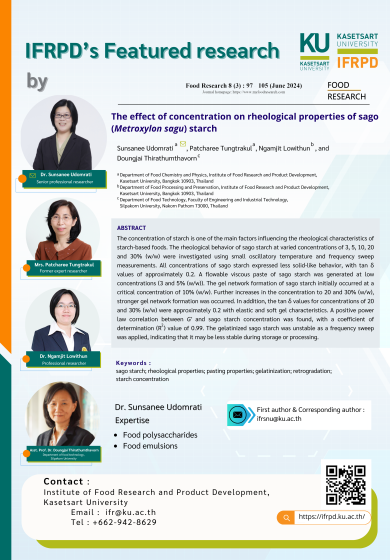| ผลงานวิจัย | ดร.ศันสนีย์ อุดมระติ และคณะ |
| Keywords | sago starch; rheological properties; pasting properties; gelatinization; retrogradation; starch concentration |
| Telephone | 0 2942 8629 (1503) |
| ifrsnu@ku.ac.th | |
| URL | https://doi.org/10.26656/fr.2017.8(3).215 |

The effect of concentration on rheological properties of sago (Metroxylon sagu) starch

| ผลงานวิจัย | ดร.ศันสนีย์ อุดมระติ และคณะ |
| Keywords | sago starch; rheological properties; pasting properties; gelatinization; retrogradation; starch concentration |
| Telephone | 0 2942 8629 (1503) |
| ifrsnu@ku.ac.th | |
| URL | https://doi.org/10.26656/fr.2017.8(3).215 |
จุดเด่นผลงาน
บทสรุป : ศึกษาสมบัติหนืดยืดหยุ่น (viscoelastic property) ในแป้งสาคูที่ระดับความเข้มข้นที่แตกต่างกันโดยการตรวจวัดทางรีโอโลยี (Rheology) ซึ่งสมบัติหนืดยืดหยุ่นของเจลแป้งสาคูสามารถใช้อธิบายและบ่งชี้ลักษณะของเจลแป้ง เช่น เนื้อสัมผัส (อ่อนนุ่ม-แข็ง หรือ ยืดหยุ่น-แตกเปราะ) และการตรวจวัดทางรีโอโลยียังสามารถใช้ประเมินเสถียรภาพ (stability) ของเจลแป้งสาคูในระหว่างการเก็บรักษาได้อีกด้วย โดยข้อมูลเหล่านี้เป็นประโยชน์ต่อการออกแบบและพัฒนาผลิตภัณฑ์เพื่อให้ผลิตภัณฑ์มีลักษณะเนื้อสัมผัสตามต้องการ
Abstract : The concentration of starch is one of the main factors influencing the rheological characteristics of starch-based foods. The rheological behavior of sago starch at varied concentrations of 3, 5, 10, 20 and 30% (w/w) were investigated using small oscillatory temperature and frequency sweep measurements. All concentrations of sago starch expressed less solid-like behavior, with tan δ values of approximately 0.2. A flowable viscous paste of sago starch was generated at low concentrations (3 and 5% (w/w)). The gel network formation of sago starch initially occurred at a critical concentration of 10% (w/w). Further increases in the concentration to 20 and 30% (w/w), stronger gel network formation was occurred. In addition, the tan δ values for concentrations of 20 and 30% (w/w) were approximately 0.2 with elastic and soft gel characteristics. A positive power law correlation between G' and sago starch concentration was found, with a coefficient of determination (R2) value of 0.99. The gelatinized sago starch was unstable as a frequency sweep was applied, indicating that it may be less stable during storage or processing.
Food Research, 2024, Vol. 8, No. 3, 97-105